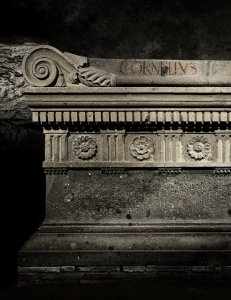Sarcophagi of Lucius Cornelius Scipio Barbatus (Tombs of Scipio), Rome
giallo antico marble
iv. – 4-1/2″ h., c. 1850, inkwell, missing lid
3500
v. -3-1/2″h., c. 1850
4500
Sometimes/more often than not/almost always, enduring forms rely as much on felicitous timing as momentous deeds.
In 298 BCE, Lucius Cornelius Scipio Barbatus, a Roman Consul, led his army to a great victory over the Etruscans at the
Battle of Volterra. Twenty-eight years later, he was dead, entombed in a particularly handsome sarcophagus,
placed in the family vault along the Appian Way, and forgotten.

Until, 2000 years later, it was rediscovered just in time to act on the imaginations of ever-increasing throngs of
Roman tourists, many of whom returned home with models of Lucius’ sarcophagus. Why were these such a hit?
They satisfy a range of curiosities- morbid and military, historical and hubristic, – over empire lost and rediscovered,
the past and the future; setting us in a Rome-antic frame of mind.


